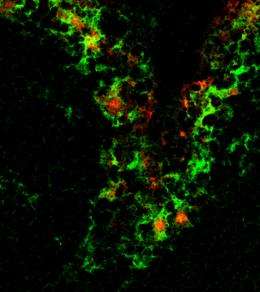Giving tumor vaccines a proper introduction

Given how effectively the immune system can eliminate foreign threats such bacteria and viruses, hopes are high for the development of strategies that might turn these same defense mechanisms against cancerous targets. However, attempts to train the immune system to recognize malignancies via the intravenous injection of vaccines that present tumor-derived antigens have fallen short.
According to Kenichi Asano, a researcher with Masato Tanaka’s group at the RIKEN Center for Allergy and Immunology in Yokohama, this is the result of ‘tolerance’ mechanisms that protect against autoimmune disease. “Billions of cells die every day, and cell corpses must be removed swiftly from our body in order not to induce detrimental effects,” he says. In this scenario, macrophage cells in the spleen clean house by devouring such debris in a process known as phagocytosis, thereby preventing dead cells from triggering an inflammatory response.
Tumor cells delivered into the lymphatic system via subcutaneous injection, however, can successfully elicit a strong immune response, and new research from Asano and colleagues explains why this is the case1. In order to rouse an effective reaction, phagocytic cells must present recognizable chunks of those dead cells to tumor-killing cytotoxic T lymphocytes (CTLs). The researchers identified a very specific subset of macrophages within the lymph nodes that perform this task.
Intriguingly, these cells, which are distinguishable by their expression of the cell-surface protein CD169, are non-migratory and reside stably within the sinuses of the lymph node, awaiting their prey like spiders in a web. Dead cancer cells delivered to these sinuses via the lymphatic system are rapidly digested by the macrophages (Fig. 1), which in turn cross-present the resulting antigens to CTLs. By selectively killing off these macrophages with diphtheria toxin, the researchers were able to essentially disable the immune response. “Without CD169 macrophages, tumor-directed T cells were no longer activated—that means these cells dominate anti-tumor immunity after tumor cell death,” says Asano.
These findings help explain why the dead cells that slough off of tumors into the lymphatic system during radiation or chemotherapy are sometimes sufficient to provoke an immune response, and could provide the foundation for far more effective cancer immunotherapy strategies. “I believe it is very promising to mount anti-tumor immunity in patients with solid tumors by delivering tumor antigens specifically to CD169 macrophages,” says Asano. “It's my dream to invent artificial materials that possess the characteristics of dead cells and are safe for administration to patients.”
More information: Asano, K., et al. CD169-positive macrophages dominate antitumor immunity by crosspresenting dead cell-associated antigens. Immunity 34, 85–95 (2011)















